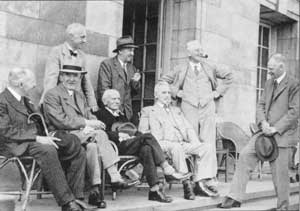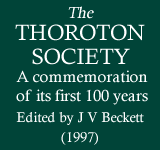The Record Section, having begun in 1903, published four volumes before it lapsed in 1914. This was of particular concern to T.M. Blagg, who remained a frequent contributor to Transactions even after he moved to Buckinghamshire on becoming a partner in Phillimores in 1910. Blagg was instrumental in reviving the Record Section in 1935, when he became its general editor. Since then it has published many volumes. The series has been particularly strong on medieval inquisitions post mortem, and monastic cartularies and charters (including Newstead and Blyth). It has also published poll books, probate inventories, coroners’ inquests, clergy lists, W.E. Tate’s pioneer work on Nottinghamshire enclosures, and the eighteenth century diaries of Nottingham socialite Mrs Abigail Gawthern. It achieved something of a milestone in 1962 by publishing a twentieth-century text (the first county register of motor vehicles, for 1903), which it followed in 1990 by publishing the Rufford miners’ union minute book of the 1920s and 1930s. It has now published more than forty volumes.
Blagg died in 1948, when he was succeeded as secretary and editor of the Record Section by Keith Train. In subsequent years the Section increased both in membership and in academic stature, acquiring library and university members from around the world, particularly from North America. Professor Sir James Holt, Professor Robin Storey and Dr David Crook successively followed Keith Train as the Section’s editors.
 |
Golden Jubilee Celebrations, University of Nottingham,
June 1947. |
The Thoroton Society celebrated its Golden Jubilee in 1947, when 400 members and their guests gathered at the Highfields campus of the University College. Each member was presented with a copy of A.C. Wood’s History of Nottinghamshire. From 1938 Wood jointly occupied the editorial chair of Transactions with the then Professor of History, Leonard Owen. As part of the celebrations the Society held a reception at which T.M. Blagg was the guest of honour and principal speaker. Blagg was the only survivor from the original meeting of the Society in June 1897, and he was well aware of the changes which had occurred, including ‘the complete disappearance of the county families as a caste, and the noticeably lower standard of scholarship among the clergy’. He clearly regretted the passing of the days when, on visits to country houses, the Society was greeted by the aristocratic owner even if, as at Wollaton, Lord Middleton had necessarily to lead the intrepid excursionists ‘candle in hand (there were no electric torches)’ into the lower recesses of the house. Of the clergy he noted with splendidly acerbic gusto:
The change in the country clergy, who at the foundation of the Society were so prominent in its support, is largely consequent on their being no longer chiefly from residential universities, where a liberal education and living contact with men of varied scholarship and interests had given them catholicity of tastes. Now, so great a proportion of them have received only a vocational education and lack the instincts of the general scholar.
Whatever the accuracy of his view, few could argue with his figures: in 1897 forty-five of the 234 members (20 per cent) were country clergy, but in 1945, with over 500 members, just eighteen (4 per cent) were paid up.[23]
In October 1947 the Lord Mayor of Nottingham hosted a Civic Reception at the Council House, with a buffet and an exhibition of the city charters and the civic plate. Distinguished lecturers during the year included Sir Leonard Woolley, Professor Hawkes, and Margaret Wood.
Transactions was also fifty years old, and although it had regularly carried prestigious articles such as A. Hamilton Thompson’s paper on Newstead in 1919, Wood took the opportunity to reflect at greater length on the purpose of the annual publication. Originally it was intended that the Transactions should include ‘papers read relating to the antiquities of the county’, although this rather narrow definition was broadened to include ‘papers on antiquarian, genealogical or historical subjects relating to Nottingham and Nottinghamshire’. The early volumes paid more attention to Society excursions than to academic study and for the first twenty years or so ‘a great deal of space was devoted to architectural descriptions of local churches’. It was not until the 1920s that articles on local history, topography and architecture came to predominate. In Wood’s view these were ‘designed to enlarge the corpus of knowledge of Nottinghamshire history rather than to record the year-by-year doings of the Society’, although even then church studies continued to fill a good deal of space. Wood had doubts about such contributions: ‘the aim of the Transactions should surely be ... to place on permanent record information which will swell the sum total of our knowledge of local history and so help students, both now and in the future’. His aim was to move the Society away from its fascination with churches towards ‘other sides of life in the past’, including agricultural and industrial developments as well as family histories.[24] In reality he frequently found the only way to do this was to write the articles himself! During twenty years as editor Wood contributed twenty-eight articles to Transactions. In the words of one of his colleagues ‘local studies monopolized his attention’.[25] He was President of the Society 1953-61.
After World War II the Society continued to flourish. In 1956 Holland Walker was succeeded as secretary by Myles Thoroton Hildyard, a descendant of Dr Thoroton’s brother. Mr Hildyard, who still lives at Flintham Hall, was awarded an M.C. for his wartime activities following the German invasion of Crete. He subsequently returned to Nottinghamshire to farm at Flintham, and after relinquishing the position of secretary he became President in 1961.
Keith Train (1905-85) became secretary in 1961. A chemistry master by profession, he had joined the Society in 1946. In 1948 he became honorary secretary and editor of the Record Section, and the same year he began contributing to Transactions. Over the next thirty-five years he was to make a distinguished contribution to the work of the Society, as honorary secretary 1960-71, editor 1971-4, chairman of the Record Section 1960-84, chairman of Council 1971-84, and a vice president from 1975: ‘for a quarter of a century he was the Thoroton society; he imparted to it his standards of scholarship, and his knowledge of Nottingham and the county were always apparent Keith Train was the author of numerous books and papers, not only of an academic nature, but at a more popular level with works aimed at the general reader. He also became a popular broadcaster on Radio Nottingham, which was founded in 1967. His seven series, ‘Train on Churches’, and his book of the same title, are well remembered and still in demand: ‘In local historical terms Keith Train was in many ways an antiquarian of the old school, but one of the best sort and a worthy successor to Dr Robert Thoroton’.[26]
Keith Train’s great friend, Professor Maurice Barley (1909-91) joined the Society in 1947 when he became a member of the Department of Adult Education at the University of Nottingham. A frequent contributor to Transactions, Professor Barley served on Council for many years, was editor 1959-70 (with Dr Richard Smith), and a vice president from 1974 until his death. He had a worldwide reputation as local historian, student of vernacular architecture, and archaeological pioneer, and apart from his active role in the Thoroton Society he was the first Professor of Archaeology at the University of Nottingham, the first chairman and later President of the Nottingham Civic Society, chairman of the Nottinghamshire Building Preservation Trust, and for twelve years chairman of the York Archaeological Trust, during which time he oversaw the launch of the Jorvik Centre. He was also a vice president of the Society of Antiquaries.
The Society’s programme, since its inception, has included winter lectures and summer excursions. The speakers have been distinguished archaeologists and historians. In the Society’s early years their subjects were mainly local subjects with buildings, particularly churches, and archaeological sites, especially popular. Between the wars the Near and Middle East featured. In 1933 lectures were delivered on ‘Excavations at Jericho’ and ‘Palestine’, and the following year on ‘Travels in and Excavations in Syria, Iraq and the Country of the Devil Worshippers’, and ‘The River Nile’. The Society managed throughout the 1939-45 war period to continue its programme of lectures which were held, until 1955, in the George Hotel, Nottingham, on alternate Saturday and Thursday afternoons. Titles, until the late 1 950s, were reminiscent of articles in Transactions, often relating to pre-history, church architecture and – reflecting the influence of the Archaeological Section – excavations. Not all the lectures were on local subjects – ‘Irish Cathedrals’, ‘Jericho’, and ‘Some Greek Sites in Sunshine – a Holiday Notebook’, suggesting catholic tastes among the audience. Just as the range of articles in Transactions broadened noticeably in the 1950s and beyond, so the range of lectures also widened. Professor David Chambers lectured on ‘Victorian Nottingham’. He had joined the Society in 1927 and became a member of Council in 1959 and a vice president in 1961. He published a number of articles in Transactions, led excursions, and lectured to the Society. Keith Train called him ‘a guileless, good man’.[27]
Other lecture subjects included ‘Aerial Reconnaissance and Roman Britain’, ‘Industrial Archaeology’, ‘Place Names’, ‘Population Studies’ and ‘The Luddites’, as well as a range of talks on canals and railways. A recent innovation has been the introduction of the Nottinghamshire History Lecture, sponsored by Nottinghamshire County Council and given by a new researcher speaking on the subject of their work.
The task of finding suitable venues for talks has not always proved easy. Since leaving the George Hotel, the Society has used a number of different premises in Nottingham, most recently the Cathedral Hall on Wellington Circus and, currently, the YMCA on Shakespeare Street. The preference of members for a city centre venue, and a Saturday afternoon time slot, may seem unusual, but audience numbers suggest it is not unpopular. From the earliest days it was intended that lectures should be illustrated, and Bernard Beilby, who became honorary lanternist in 1961, still holds the position, now with his wife Joyce, although the advent of 35 millimetre colour slides and overhead projectors has somewhat reduced the role.
The excursions have in the past, and still have, a social as well as an intellectual element, giving members a chance to meet on an informal basis. One current member of the Society recalls the awe in which he held the impressive scholarship of some senior members of the Society when he first joined in the 1950s, particularly their willingness to conduct a fierce argument over, for example, whether dog tooth ornament was early or late thirteenth century: ‘in those days two or even three coaches were needed for excursions, most members of the Council would be present and share their knowledge with lesser mortals’.
